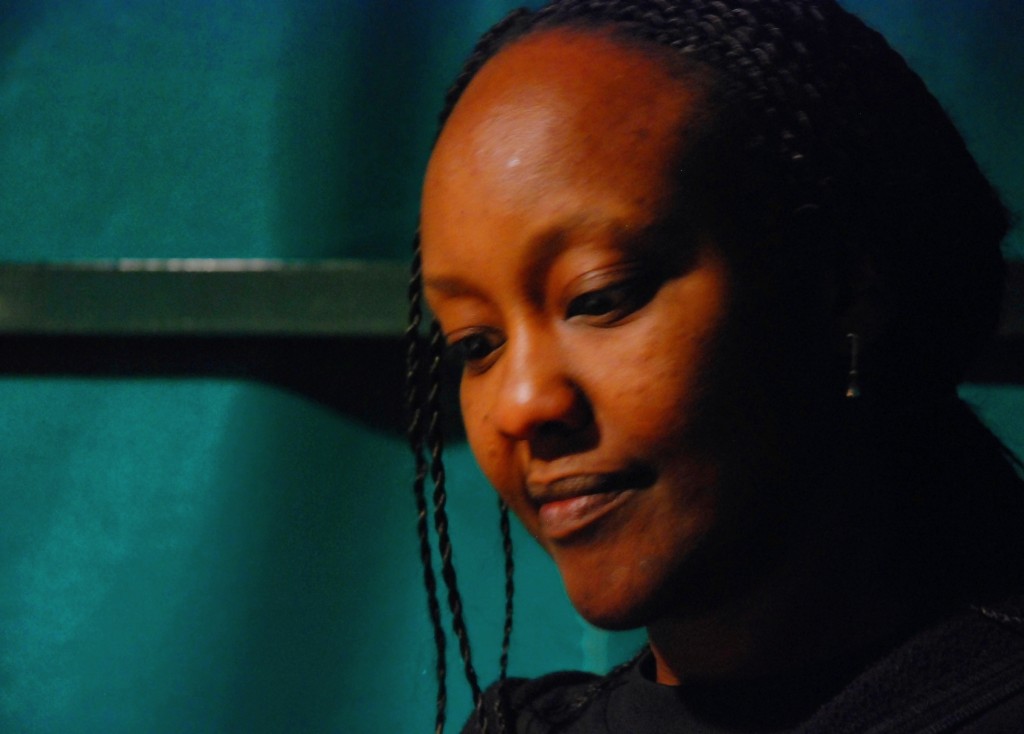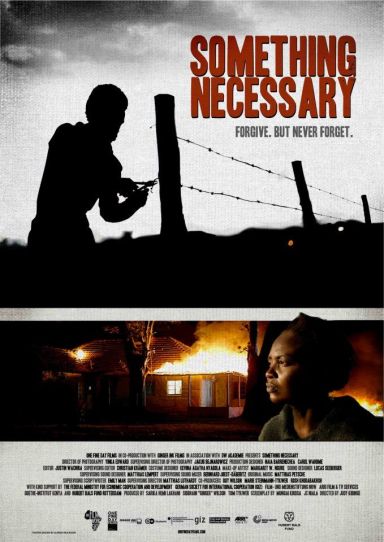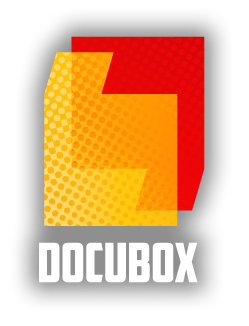JUDY KIBINGE
__________________________
http://www.youtube.com/watch?v=ckdS9PEkoQQ
Q&A:
Judy Kibinge
– Writer, director and film maker
BY KATE HAINES
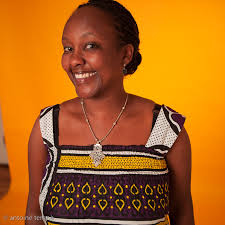
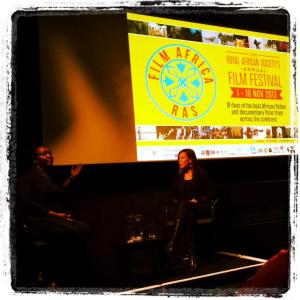
To make the film the kind of film that I felt I had to make, which is not at surface-level but a film with really in-depth characters, demands that you then look at Anne as a Kikuyu – because she is a Kikuyu. But how do you have this Kikuyu woman who loses everything without making it an ethnic story? And how do you tell Joseph’s story without having lots of political commentary about the Kalenjin and their role as a whole in the politics of the country? And if you show the commission, what should people in that commission be standing up to say and do you explore the outcome of that commission or not? All of these things just seemed too close and claustrophobic. Everybody is so sensitive about what happened and views are so strong, but yet they are unexpressed.
Having said that, I’m really happy that we made the film when we did. You know the further away you get from an event, the more your memory steps into repaint it and the more the things that affected you are stronger. So, I’m just really glad we made it then, because I think it captures a certain mood. I’m particularly proud of what we managed to do with the characters Anne and Joseph, as I think they are so typically Kenyan. There is a hysteria that you imagine accompanies loss and violence, but this woman completely typifies how so many Kenyans deal with life. You can lose everything, but you just get up in the morning and you try and rebuild. Joseph’s character turns up in an earlier film I made – Killer Necklace – which tries to answer the question ‘why would a young Kenyan guy with a potentially bright future, even though he is from a poor household, turn to crime?’ And this is exactly the same question and it is exactly the same age guy. I did a lot of writing and built up the character of Joseph because I’m fascinated with that guy. I feel like that age of guy – late teen, early 20s – is the reason why Kenya exploded – the frustration, the unemployment all those things. So I’m really glad that Joseph and his very complex feelings of anger, frustrations and then guilt have been captured in the film.
I’m interested not only in the story you were trying to tell, but what was important to you in terms of the way the story was visually constructed. Can you talk about shooting the film and whether was there was a particular mood or ideas you were trying to evoke through the location and setting of particular scenes and interactions?
Because the film was trying to be so true to the characters, the way we shot the film really reflects that as well. Almost all of the film is shot in very long takes. This sort of film making sounds very easy to do, but it is actually not. It is quite complicated because then it affects how you edit – you are not doing your wides, your mediums, your close. You are starting off with a character, you are following them, you are sometimes allowing them to walk in and out of frame. You are turning with them, you are introducing other key characters within the same shot without cutting. And you are trying to do this in a way that doesn’t feel tedious. So – very difficult to do.
There are also a lot of tableaus or wide scenic shots in the middle. This was set up while we were at script stage because I really wanted to feel the vastness of the landscape and these individuals within those spaces. The violence itself was very claustrophobic and there are times in which you feel that in the film, even in the way we follow people and so on. But I felt that somehow we needed these great big wide visual shots to breathe and express the kind of distances that these characters were implanted in.
The film begins with some pretty brutal footage – archive news footage. The whole idea was to try and bring the viewer from the things they are used to seeing on the screen, that make them think they understand Africa, and slowly as we move from archive into this quite beautiful landscape it is a kind of a seamless transition. So at one point you are thinking ‘silly Africans fighting each other again’ and then the next thing you are into this woman’s head, her life and an intimate portrait. The hope was that doing this would help change something in the way you think about what you see on television and what people really are.
It must be quite a different experience to screen this film in Kenya, and then to bring it to international film festivals. How has the film been received inside Kenya and outside?
One thing that was very intense was that we completed the film at the beginning of 2013 and our next elections in Kenya were in March 2013. So you can’t imagine what this was. This country that had gone through this horrible post-election violence in 2007 and then five and a bit years later, here we were about to show a film before the next elections with so many people anxious about what that would mean, and what would happen and what wouldn’t happen. The first week was very well attended but after that, even many friends told me that they wanted to come and see it but they just couldn’t bring themselves to. I suppose they were fighting with so many personal fears about what was coming and the last thing they wanted to do was sit in a cinema and re-experience all the fears that they’d had five years ago.
So a lot of mixed feelings. A lot of people who saw it were just intensely moved by it. Some of the reviews talked about it being the best acting yet in a local or a Kenyan film. Some people thought there were scenes that were unnecessarily violent. I think there is one particular scene, an abortion scene, that shocked and I think it has surprised people not just at home but elsewhere in the world. Bringing it here I feel is more about curiosity, a lot of whys and especially given what is happening now with the Hague. I think people feel the film gives them a glimpse into something they didn’t know very much about, but at home it is really something that people might rather forget. So a difficult film because of that. I want my next film to be more entertaining – we have enough horror in our day-to-day life without having to go to the cinema and watch it as well.
You also directed a documentary Peace Wanted Alive which explores the aftermath of the post-election violence in Nairobi. Can you talk a little bit about that project?
After the violence, as an artist or as a film maker or as anyone, everybody felt lost. I remember my Mum one day saying ‘I’m so depressed’ and I was like ‘so am I’ and then we just sat there. The whole country was depressed for maybe two years. It was horrible, like this big cloud hanging in the air. Peace Wanted Alive came out of the desire to just do something that helped try to find answers.
One thing I noticed was that if you watched the news, you always saw our same old politicians talking their same old crap and you didn’t really see any stories of heroism – you didn’t hear any proactive young new voices. What I wanted to do was explore the violence through six pairs of young eyes. I followed the story of this amazing artist called Solo Seven, Solomon Seven. Solo Seven did thousands of pieces of graffiti all across Kibera, the biggest slum in Africa. If you walk through Kibera even today you just see big big ‘peace’ written everywhere and ‘peace wanted alive’ was the thing that he kept writing. His reaction to the violence as an artist was just to paint his graffiti everywhere appealing for peace. Then I followed another guy, who was only 29 and started picking up orphans from all over the country and bringing them back to his home. There were also two radio DJs who worked in a community station in Kibera, describing how they saw things unfold. I took six voices on the same timescale and just intercut their stories, and then took the footage we’d been used to seeing on the television and intercut that too. I thought it gave a very different memory or record of the violence, because it was told from the perspective of people who were on the ground seeing things and who also tried to do something rather than just watch or hide or turn against their neighbour. It was my way of trying to feel positive in a very depressed time, while also just having a detailed record, intercut with lots of archive footage of what happened.
There was a significant literary and artistic response to the violence across film and television, but also from writers and photographers. How significant do you think initiatives such as the Kwani? 05 special issue or the ‘Kenya Burning’ exhibition were? Are there ways in which your work enters into dialogue with responses to the violence across other media?
I’m just always struck when you look back at really important points in our history, turning points like 2007. When you look back earlier – there is no record. There is no easily accessible record even of independence. I find it really frustrating that when you look for footage of 1963 what you find is a frozen moment – this stadium in the night and it is frozen, it tells you nothing and that is your collective history. So I like to look at ‘Kenya Burning’ andKwani? 05 as things that will influence who we are and how we remember the points at which Kenya turned or changed in the future. I think ‘Kenya Burning’ made a great impact, but I think the audiences were not as big as they should have been. Even though that exhibition did travel to certain places, it was exhibiting to people who already knew or believed that horrors had happened. There was also Pichaa Mtaani by Boniface Mwangi, which took where ‘Kenya Burning’ started and just took it further. That is what he does, he takes things and makes them get seen – he is incredible. Kwani? 05 I think is so important because it recorded texts as documents.
I think violence of this kind happening forces you to ask yourself whether, as a writer or as an artist or as a film maker, you have any kind of responsibility – and I always used to say ‘no’, ‘no, of course not – I just make film’. But then suddenly here this thing is and you do have at yours hands something that you can use to do something a little bit wider. So it was a coming of age time, for me at least.
Who are the film makers, writers and directors that inspire you to do what you do?
I recently saw a short film by a film maker at home called Benji Mureithi which was just really dark and interesting. When I see films like that I’m just really astonished at the sorts of things that people are managing to make with almost nothing and I find that really inspirational.
If you are looking at bigger films, then really it is people like Tarantino and Paul Haggis. I mean I just love Crash – I can’t tell you how much I love that film! When I first watched it and it ended, I just got up and rewound it and watched it again. It is set in LA, I think at the time of the race riots, but yet it is enormously entertaining. It shares incredibly intimate observations of these characters trapped inside their race, or trapped inside their neighbourhoods or trapped inside their perceptions of other people – and that is very much Kenya with its different tribes. I love the film because off it went and won its Oscar for best screenplay and best picture, but yet it tackled things that people don’t say. I remember later reading about what people in America said when they watched that film – they had never heard themselves as Americans talking about race to each other aloud in that way.
Which films from the last decade would you say have been influential in terms of how people in Kenya think about the past?
When we did Dangerous Affair in 2002, that changed something in a big way. I think until that point people were used to African or East African film meaning a certain thing – it had to have a message within the content. So when Dangerous Affair came along and just portrayed the life of this group of young people, just living and getting jobs, losing jobs, sleeping with each other, getting married to each, cheating on each other, drinking, hungover, clubbing with popular music that was also on our airwaves being sung live within the scenes of the film – I think all those things really surprised people. At home I still can’t get over how much it shocked people and you’d also have foreign journalists presumptuously saying ‘but that is not an African film’!
The other film I think has had great impact is Nairobi Half Life, from the same producers asSomething Necessary and written largely by Billy Kahora. I love it, maybe because again it explores the question I’ve kept trying to answer in other films of why young men become violent or become criminals. I think it resounded with me personally because of that, but clearly it resounded with many people because of many things – a fantastic soundtrack, a contemporary gang story but telling a larger story about a city and the young people within that city. I love what Nairobi Half Lifedid and continues to do – the kind of following that the film has at home is really special.
Finally, what are you currently working on and what plans have you in view for future projects?
I’ve just started an organization called DOCUBOX that is seeking to a start a community of East African film makers. We will be giving 12 grants in December of $2,000 each to make trailers for documentary films. Out of those 12 at the end of February we pick a maximum of 6, minimum of 4, and give them up to $25,000 each to go off and make films with. We’ve got people like Lindiwe Dovey who will be helping with the selection and John Akomfrah on our advisory board.
One of the things that was important to me when putting the idea together was starting a dialogue that would change the film making landscape in Kenya. With Kwani? there was such a strong body of debate, of critical thought – we’d argue until 7am! That kind of thing does something, it started a real literary community and I think we don’t really have that space as film makers. We don’t have to all hang out, but at least this can be a place where people network, see what other people are doing and watch great films.
DOCUBOX has taken up a lot of time and I’m using these travels to talk a lot about the fund. There are couple of future projects I have in mind that I’d like to do, but it is quite difficult when people come up to you and say ‘there is this project we’d like you to do’. That is in a sense what happened with Something Necessary through the One Fine Day workshop. The work I’d love to do is still on the horizon, but for now DOCUBOX is definitely the big passion.
Watch the trailer for Something Necessary here.
Watch Film Africa Festival Manager Sheila Ruiz asks Judy Kibinge three key questions here.
Read Judy Kibinge on film making in Kenya past and present here.
>via: http://africainwords.com/2013/11/08/qa-judy-kibinge-writer-director-and-film-maker/#more-4282

